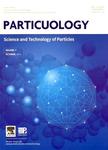Giant electrorheological effects of aluminum-doped TiO_2 nanoparticles
Giant electrorheological effects of aluminum-doped TiO_2 nanoparticles作者机构:Beihang Sino-French EngineerSchool Beihang University Beijing 100191 China Functional Nanomaterials Laboratory Technical Institute of Physics and Chemistry Chinese Academy of Sciences Beijing 100190 China LCMI - University ofFranche-Comte 16 route de Gray La Bouloie 25030 Besancon cedex France
出 版 物:《Particuology》 (颗粒学报(英文版))
年 卷 期:2010年第8卷第5期
页 面:442-446页
核心收录:
学科分类:083002[工学-环境工程] 0830[工学-环境科学与工程(可授工学、理学、农学学位)] 081702[工学-化学工艺] 0817[工学-化学工程与技术] 08[工学] 0805[工学-材料科学与工程(可授工学、理学学位)] 0703[理学-化学] 0702[理学-物理学]
基 金:Sponsored by the Scientific Research Foundation for the Returned Overseas Chinese Scholars State Education Ministry and the Central University Basic research and operating expenses for grants
主 题:Electrorheological fluidIonic potentialSurface structureAluminum ions
摘 要:Titania nanoparticles doped with cations have been synthesized via a modified hydrolysis method. The X-ray diffraction analyses, scanning electron microscopy and other characteristics measurements, were used to study the structure of the nanoparticles. The results showed interesting electrorheological (ER) effect with titania nanoparticles modified by aluminum ions, and different cations on ER effect were determined by ionic potential and resistance of the particle aggregates in the electric field. The doping ratio of aluminum ions was dominated by the appropriate sites of the particle surface and the ER effect strongly depends on the doping ratio.



